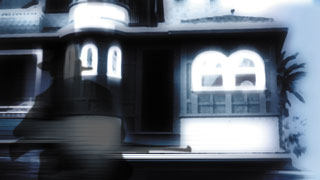Jeremy Blake: The Winchester Trilogy Review
On-Site Gallery, Reinberger Galleries
Cleveland Institute of Art
Cleveland, Ohio
October 22 – November 19, 2005
Originally printed in the January/February 2006 issue of Afterimage
 Inspired by firearm heiress Sarah Winchester’s 160-room late nineteenth-century mansion located in San José, California, video artist Jeremy Blake created The Winchester Trilogy , a series of three time-based paintings. These works, Winchester (2002), 1906 (2003), and Century 21 (2004), were recently on view at the Cleveland Institute of Art in the On-Site Gallery, a new “laboratory” gallery space that feature projects by artists working in digital, installation, or experimental media.
Inspired by firearm heiress Sarah Winchester’s 160-room late nineteenth-century mansion located in San José, California, video artist Jeremy Blake created The Winchester Trilogy , a series of three time-based paintings. These works, Winchester (2002), 1906 (2003), and Century 21 (2004), were recently on view at the Cleveland Institute of Art in the On-Site Gallery, a new “laboratory” gallery space that feature projects by artists working in digital, installation, or experimental media.
Beginning in 1884, Winchester, on the advice of a spiritual advisor, embarked on a thirty-eight year building campaign to augment her home in an effort to confuse the ghosts that she felt might harm her. The result was an eccentric, sprawling mansion with 950 doors and 467 doorways; some leading out into open air several stories above the ground. Using Winchester’s mansion as a metaphor, Blake combines abstract and representational imagery mixed with vibrant hues to explore the hauntingly inner workings that surround this woman’s quest to flee the angry spirits she believed were struck down by her family’s guns. Blake writes that the pieces “are meant to provide an abstract and emotional tour—not so much of the architecture, but of some of the more fearful chambers of Sarah Winchester’s mind.” (1)
The first work created in the trilogy, Winchester , explores the exterior of the pristine building in its heyday with its well-manicured grounds. The black-and-white imagery blurs in and out of focus and changes hue as a gunman’s silhouette melds into Rorschach ink blot imagery. In his artist statement, Blake writes, “The figure of the gunfighter (whether lawman or outlaw) who facilitates spiritual regeneration through violence is treated with reverent fear here, as are the ghosts of his victims.”(2) More of an abstraction than a narrative, the piece introduces the viewer to the Winchester mansion with its beautiful, yet odd, architecture focusing on an exterior door that is high off the ground but has no steps. Like the other works in the trilogy, this piece is a looping DVD projected in a darkened room, accompanied by eerie organ-like music and the recorded sounds of a traditional film projector.
1906 also uses haunting surreal imagery; however, this piece primarily explores the interior of the mansion that suffered from the 1906 earthquake. Painterly strokes similar to Arshile Gorky’s Abstract Expressionist painting and Joan Miró’s surrealist work intertwine with fragmented imagery of the house’s earthquake-damaged interiors with their lath exposed plaster walls and torn wallpaper. Period music plays throughout the work while sounds of construction cycle in and out of the piece. In an interview with Holly Willis for RES Magazine , Blake states that he focused on the earthquake sections which “Sarah [Winchester] left alone—she thought she was being punished by the spirits with the earthquake, and she thought that the parts of the house that fell were not to their liking, so she built around them. For me that was a great example of how we deal with trauma—it’s the basic architectural manifestation of trauma.” (3)
Century 21 focuses on the area surrounding the mansion—specifically three movie theaters. Blake writes, “ Century 21 moves from the roof of the Winchester house to zoom in on a complex of three domed, space-age movie theaters situated across the street: Century 21, Century 22, and Century 23, alluding to the fact that it is film, TV, and the media that perpetuate the icon of the gunfighter.”(4) As the viewer watches Century 21, they sense that they are in the midst of a showdown as one fragmented image shifts to another. Images of gunfighters from old western films intertwine with cartoon images and drawings of revolvers perpetuating a hallucinatory acid trip gone wrong. Flashes of light and sound intermittently interrupt the slow-moving overlapping imagery, startling the viewer.
Blake also writes in his statement that the “entire series is informed by the idea that the Victorian aesthetic (embodied by the mansion’s architecture) and the psychedelic sensibility (referenced through hallucinatory manipulation of film) are sympathetic opposites.”(5) Much like Winchester’s mind, the mansion’s eccentric design embodies the inner turmoil and fear that engulfed her after suffering the death of her child and husband. Blake successfully presents innovative semi-narrative works that explore the relationship between Winchester’s mind and her habitat.
NOTES
1. Jeremy Blake, The Winchester Series Artist Statement. Feigen Contemporary, 2004. See www.feigencontemporary.com.
2. Ibid.
3. Holly Willis, “Gunslinging Psychedelia: The Moving Paintings of Jeremy Blake,” RES Magazine (2005), 60-61.
4. Blake, Ibid.
5. Ibid.
Posted March 2006